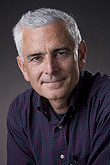Measuring the tick-tock of space-time
Craig Hogan, head of the Center for Particle Astrophysics, wrote this week's column.
 |
| Craig Hogan |
These days, nobody can escape the space-time grid. Your cell phone's GPS knows time to sub-microsecond precision, and hence can pinpoint your position in space and time to a few meters. (Cell phones transmit signals at the speed of light, which translates the uncertainties in seconds to uncertainties in meters.)
However, no clock is perfect; even timekeeping on the best atomic clocks drifts randomly by a few parts in a million billion, or 1015, every second.
That raises the question: could there ever be a perfect clock? A blend of quantum mechanics and gravity theory suggests that there is a minimum time period associated with the Planck scale, about 5.39 x 10-44 seconds long. If that is the minimum length it takes to transmit a bit of information, then the maximum transfer rate for nature's best Internet connection would have a bandwith of 1044 bits per second. It would also be the maximum tick rate of any clock.
If both space and time are subject to this limit, it's possible that you only get to achieve this bandwidth in one direction at a time. If so, this would mean that measurements oriented in different directions randomly drift apart due to a fundamental noise of space-time. That drift in space-time would be about one part in 1022 every second-a lot longer than the one-dimensional minimum time period but a lot smaller than atomic clocks can measure.
The good news: we might be able to build a machine that can detect this fundamental jitter in space-time, if it exists. As a matter of fact, over the space of less than a microsecond, we aim to detect drifts of about 10-25 seconds--- about the time it takes a single pair of particles at the Tevatron to interact.
At Fermilab, we have begun to build a prototype of such a machine. We call the machine a holographic interferometer, or holometer. Our holometer will measure time by measuring the phases of laser light. We will send light through 40-meter tubes in two different directions and compare their "tick-tocks" (the phases of the laser light waves) when the reflected light comes back, a fraction of a microsecond later. The phases should disagree, due to nature's bandwidth limit, by a very small amount. The holometer will compare the jitter in two pairs of tubes to check that the effect is caused by space-time and not some other source of noise.
Of course, we might see no effect at all. We could take comfort in that, too, since it would mean that nature is a faster information service provider than we thought.
|